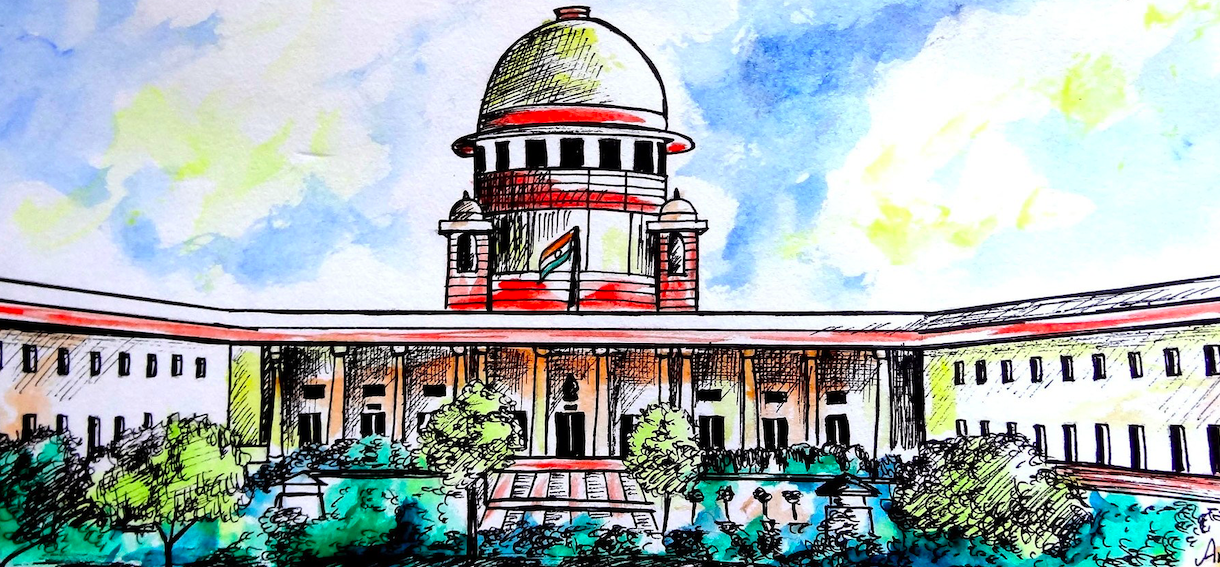
Introduction
One of the most eminent jurists, A.V. Dicey expounded the principle of Rule of Law which rests on three essential cardinal principles. The first of these principles states that there needs to be an absence of arbitrary power, the second states that there needs to be equality before the law and the final principle talks about providing individual liberties to the citizenry.[1] The Indian Constitution has not formally recognised the concept of Rule of Law, however, the makers of the constitution have incorporated provisions which uphold its cardinal principles. In order to ensure that there is an absence of arbitrariness in State action, the Constitution has adopted the doctrine of separation of powers wherein the functions of the different parts or organs of the government have been sufficiently differentiated. The separation of powers enable state organs to work in a more effective and efficient manner with little to no overlap for these organs to meddle over. This separation of powers between the Legislature, the Executive and Judiciary has been recognised as a part of the basic structure of the Constitution by the Supreme Court.[2] In recent times however, there have been multiple instances where the judiciary has overstepped its jurisdiction and passed orders which are nothing short of arbitrary and have no backing of the law or the Constitution. These unlawful interventions carried out by the judiciary pose a severe threat to the fundamental nature of India as a nation as it is slowly robbing the legislature of its autonomy and in other cases, being the root cause for a discriminatory outlook towards certain sections of society and religious groups.
The absence of any constitutional or legal mechanism to keep the judiciary itself in check is the primary reason which has led to the judiciary arbitrarily expanding its jurisdiction under the guise of “judicial activism” and has only done more harm than good in recent times. It is therefore, imperative that some form of restrictions be imposed upon the jurisdiction of Courts in order to effectively deal with this issue and preserve the vision that the makers of the Constitution had for India.
Judicial Review and its Origin
The Supreme Court of the United States established the principle of Judicial Review in the case of Marbury v. Madison which struck down a provision of an enactment passed by the legislature on grounds of it being ultra vires of the Constitutional Principles of America.[3] The Constitution of India through Articles 32 and 226 vest the Supreme Court and the High Courts respectively with the power to review actions of the State, primarily law making, to ensure that they are in compliance with the Constitutional Mandate i.e., the legislature possesses the requisite legislative competence under Article 246 & Schedule VII and that the law enacted is not violative of any of the rights listed under Part III of the Constitution.
The scope of judicial review has been expanded by the Apex Court of the nation through the passage of various judgments on this subject matter. Over the years, the Supreme Court and the High Courts have used the power of judicial review to preserve and protect the fundamental rights of the citizens of India and have upheld basic human values such as the right to privacy[4] and the right to dignity.[5] However, there have been multiple instances where the Courts have intervened in matters without the authority to do so and have set aside established principles of law in the most arbitrary fashion. The Supreme Court itself in State of Kerala v. A. Lakshmi Kutty observed that there is a fine line between judicial activism and overreach and that judges should be weary as to not take an “over-activist” approach so as to ensure that they do not entrench upon the powers and fields of the other two organs of the State.[6] However, looking back at some of the actions of the judiciary, restraint seems to be the last thing on their minds while listening to cases and passing orders.
The Sabrimala Debacle
Sabriamala is one of the most prominent Hindu temples located in the state of Kerala. On 28 September, 2018, a Constitutional Bench of the Supreme Court comprising of Chief Justice Dipak Mishra, Justice Nariman, Justice Chandrachud, Justice Khanwilkar and Justice Indu Malhotra through a 4:1 majority verdict held that the practice of barring women between a certain age was unconstitutional and violative of the principles of constitutional morality and the right to equality provided under Article 14.[7] This verdict was a shocking blow to the religious freedom guaranteed by the Constitution under Article 25 and 26 which ensure that all citizens shall have the right to practice and profess any religion and protect certain essential practices. A practice which has been followed over centuries cannot be held to the same rational metric of today’s standards because as Justice Indu Malhotra stated in her verdict, “notions of rationality are impervious to religion”.[8]
The Supreme Court held has in the past held that no secular authority of the State has the authority to determine what can and cannot be classified as an essential religious practice[9] and that the religious denomination is the one that has the authority to decide what practices are essential according to the tents of the religion they follow.[10] However, the majority opinion, in this verdict, in clear contradiction of such established legal principles went ahead and declared a practice to be non-essential and declared it ultra vires the Constitution. The verdict did not go down well with a large majority of the population, including the women who worshiped lord Ayyappa with hundreds and thousands taking to the streets in protest against this verdict. Furthermore, the Court’s reluctance to handle issues regarding women’s rights in other religions has been a major point of debate with numerous people claiming the Court itself is incapable of maintaining any form of consistency. This is backed by the Court’s recent dismissal of a petition for removal of certain verses of the Quran on the grounds that it fosters and promotes religious extremism. In this case, no sooner did the Court consider the petition than they disposed it as a frivolous plea and ordered the petitioner to pay Rs. 50,000 in costs.[11]
The Farmers Clash
The Union Government passed a series of controversial farm laws late in 2019 which continue to face strong opposition from the farmers and the opposing political parties to this very day. A petition challenging the constitutionality of these enactments was filed before the Supreme Court of India in January, 2021. To everyone’s surprise, without any form of hearing or declaration, the Apex Court stayed the implementation of these laws. The Courts have the authority to strike down or read down a law enacted by a legislature should they deem it to be ultra vires the Constitution. Until such conclusion is made, there is a presumption in favour of the constitutionality of such statute.[12] The Court completely disregarded this principle while arbitrarily imposing a stay order on the Farm laws enacted by the Central Government. The Court’s reasoning for taking such a drastic step, in contravention of established principles was not based on law but rather that they wanted to ensure that the protests did not escalate and cause any violence.[13] In this case, the judges have clearly overstepped their bounds by encroaching into the domain of the legislature. They have no authority to stay the implementation of a law until and unless they deem it to be unconstitutional. To arbitrarily stay the implementation of an enactment is to reject the mandate of the people since it is their representatives who have drafted and enacted the law in question. They are forbidden from assuming the role of administrators; governmental machinery cannot be run by judges as this was not envisioned by the makers of the Constituent Assembly.[14]
There have been numerous other instances wherein the Courts have intervened in matters where they had no authority to do so or simply passed an order which could not be backed by law. For example, the intervention of the Supreme Court in matters pertaining to the conduct of military operations most notably in the case of State of Jammu & Kashmir v. Jammu & Kashmir High Court Bar Association wherein the Apex Court laid down guidelines saying that food, water, lights and sanitation be provided to the terrorist and the hostages[15] was in direct contradiction to the plan of action that had been established by the forces handling the situation. These remain matters where the army and the concerned authorities are required to have complete discretion since it is a matter of life and death.
Analysis and Conclusion
Today, an unhinged and unbridled judiciary poses a sever threat to the very nature of the democracy in India. The Judiciary is not the law making body and is tasked with ensuring that the Executive and Legislature do not exceed their powers or abuse them. However, it is vital for the Courts to recognise that it is not their duty to substitute administrative orders with their judicial pronouncements.[16] The Courts should instead focus on compelling authorities to act and pass orders in the right manner instead of taking over their duties. A different approach wherein the Courts lay down the manner in which authorities should discharge their duties needs to be adopted by more judges and implemented more frequently.[17] The adoption of this approach shall also be beneficial in the long term as the Court will be providing authorities with generalised guidelines which will need to be adhered to in future cases as well, unlike the current approach wherein they pass specific orders for that one case.
While it is easy for one to sit back and criticise the actions of the Supreme Court, one must take into consideration that being a judge in the Indian judiciary is a job that brings with it massive pressure and expectations. In a country with a diverse population like India, any verdict, no matter how good, will disgruntle a section of the society. However, that still does not justify the Courts themselves passing orders which are not supported or backed by the Constitutional or any other Legal framework. Therefore, it is vital that the Courts draw a line beyond which they shall no exercise any pervasive control over the other organs of the State or absorb their powers and do the job such organs or authorities were tasked with.
About the author
Yash is a third year law student currently pursuing his B.A. LL.B. at School of Law, Christ (Deemed to be University), Bangalore. He is primarily interested in the fields of Constitutional Law, International Law and Corporate Law
Photo Source: The Leaflet
Endnotes
Dicey A.V., Introduction To The Study Of The Law Of The Constitution 110 (10th ed.,1982). ↑
Smt. Indira Nehru Gandhi v. Shri Raj Narain & Anr., AIR 1975 SC 2299. ↑
Marbury v. Madison, 5 U.S. 137. ↑
Justice K.S. Puttaswamy (retd.) v. Union of India, (2019) 1 SCC 1. ↑
Shayara Bano v. Union of India & Ors., (2017) 9 SCC 1. ↑
State of Kerala v. A. Lakshmi Kutty, (1986) 4 SCC 632. ↑
Indian Young Lawyers Association v. State of Kerala , (2019) 11 SCC 1. ↑
Id. ↑
Ratilal Panachand Gandhi v. The State of Bombay and Ors., 1954 AIR SC 388. ↑
The Commissioner, Hindu Religious Endowments, Madras v. Sri Lakshmindra Thirtha Swamiar of Sri Shitur Mutt, 1954 AIR SC 282. ↑
Syed Waseem Rivi. v. Union of India & Ors., W.P. (C) No. 401 of 2021 Order dt. 12/04/2021. ↑
P.M. Ashwathnarayana Setty v State of Karnataka,1989 Supp (1) SCC 696. ↑
Rakesh Vaishnav & Ors. v. Union of India & Ors., W.P. (C) No. 1118/2020, Order dt. 12/01/2021. ↑
R. Shunmugasundaram, Judicial Activism and Overreach in India, 72 Journal of the Society for Advanced Legal Studies 21, 23 (2007). ↑
State of Jammu & Kashmir v. Jammu & Kashmir High Court Bar Association, (1995) SCC (3) Supp. ↑
Indian Drugs & Pharmaceuticals v. Workmen, (2007) 1 SCC 408. ↑
Shivprasad Swaminathan, Schrödinger’s Constitutional Cat: Limits of the High Court’s Declaration of Unconstitutionality, 25 National Law School Of India Review 100 (2013). ↑





Hi there, I wish for to subscribe for this website to
get latest updates, therefore where can i do it please help.
I don’t even know how I ended up here, but I thought this post was good.
I don’t know who you are but certainly you’re going to a famous blogger if you aren’t already 😉 Cheers!